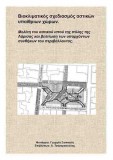Supervisor:
Technology
2008
The initial aim of this project is the investigation of the bioclimatic conventions which prevail in the urban centre of the city and their improvement.
This study attempts to approach the bioclimatic design of outdoor urban spaces and its’ application to the specific sector of the urban tissue of the city of Larissa. The goal is the improvement of the conventions of the environmental thermal comfort and the quality of life that people have.
Because of the lack of informing the majority of the city’s public in what it may concerns the way that the bioclimatic design could attribute profits to outdoor spaces by their everyday use, we attempt a first examination of all the possible improvements which could be obtained to one of the most central sectors of the city, the public square.
The tendency of ignorance that people and the authorities of the city have for the best icon of the buildings and their harmonization with the wider urban environment, drove to bad choices, basically for economical reasons, and the result was the demotion of the characteristics of the local microclimate and the excessive consumption of the buildings energy through their exterior surfaces.
We will examine specific scenarios in the area of a group of urban squares in the city centre, which are related: 1. with the materials choice, 2. the urban geometry, and will lead to the improvement of the thermal comfort.
The proceedings which were followed for the achievement of the specific target are the following:
· Bibliographical investigation of the reports and studies of the factors which contribute to the improvement of the area’s thermal comfort and more precisely of the materials contribution.
· Analysis of the area’s environment.
· Calculations of the temperature and the humidity at specific points of the area.
· Calculations, study and evaluation of the results, for the finding of the thermal comfort indicators and comments of the calculation elements.
· Application of the CANYON programme, in order to study the influence of the materials and their refraction to the improvement of the area’s thermal comfort.
· Evaluation of the programme’s results.
· Intervention to the city’s urban tissue and specifically on the area of the public square and around her on two surrounding urban channels.
Through the use of suitable computer programs we observe the changes which appear to the microclimate of the area we chose after our intervention on it and which concern the change of the surface materials and the construction of water canals on different points of the public square and on the pavements of two adjacent urban channels.
Surfaces with water can counterbalance the temperature of open spaces and increase the percentage of humidity. The right use of trees and plants can shade and ensure ventilation during the day and the whole year, decrease the temperature and regulate the speed of the air, decrease the urban noise and absorb the pollutant substances. With the suitable use of materials the increase and the decrease of temperature are reached, but also the avoidance of reflection.
From the study and evaluation of the elements we come to the following conclusions:
· The necessity of choice and use of suitable materials with such reflection indicator that will help to the improvement of the urban microclimate.
· The immediate application of the basic bioclimatic principles is considered necessary not only for the insurance of thermal comfort but also for the protection of the environment and the improvement of people’s lives.
